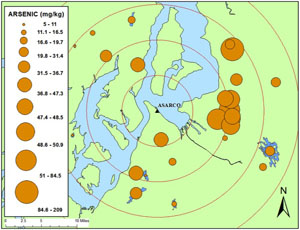
A version of this story was originally published in the Fall 2013 UW SRP eBulletin.
Dr. Jim Gawel was the invited speaker at the UW-SRP Agency Seminar at EPA Region 10 this summer. Dr. Gawel is an Associate Professor of Environmental Chemistry and Engineering, University of Washington Tacoma. Jim shared his recent research findings on arsenic fate, transport, and bioavailability in regional lakes.
His biomarker research has helped define the range of impacts of heavy metals pollution in terrestrial and aquatic systems. Urban lake systems not only support plant and animal habitat diversity but are also relevant to key segments of human populations who depend on lakes for subsistence fishing and cultural uses. As urban density continues to increase, knowledge about the mobility of arsenic deposited in lake sediments becomes more important to protecting human health worldwide. Chemical analyses show that arsenic does not remain fixed within the sediment layers. When polluting nutrients and organic compounds enter a lake there is potential for increased phytoplankton growth. Subsequently, decomposition and bacterial respiration occur in sediments and bottom waters, and the arsenic that had been held in sediments can migrate into the water column. Proposed research plans that can assist in development of water quality and sediment quality criteria were described to the agency audience.
This presentation titled ‘The Long-Term Impact of Metal Smelting Operations on Arsenic Availability in Urban Lakes of South-Central Puget Sound Region’ reached a national audience via EPA’s CLU-IN. The audio file and accompanying slides are archived here. The UW-SRP Vimeo website also hosts the presentation video-file.
The UW-SRP sponsors regular seminars held in Seattle at the regional EPA headquarters. These seminars are directed toward an audience of agency staff involved with risk assessment and communication at Superfund sites, such as EPA Region 10 and the Washington State Departments of Health and Ecology. The series provides a forum for intra-agency discussions with scientists about current research and applications of the science.

